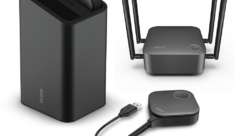
Protecting Your Intellectual Property
The AV industry is waking up to the broad issue of intellectual property (IP) ? the tangible and occasionally intangible products of designers of all stripes at AV systems solutions providers. Potentially encompassing everything from software to shop drawings to project design specifications, intellectual property is emerging as the essence of the ?product? that industry players are selling. As such, it’s increasingly being recognized as something worthy of protection, or at least appreciated for its value and wisely managed.
Ownership questions
When integrator Technical Services Audio Visual recently landed a contract to design a system for a university client’s campus building, a roadblock stopped project planning in its tracks. The “keys” to the software another AV systems integrator had used to build an earlier system that the client wanted to essentially duplicate in a new venue weren’t accessible.
Credit: Ian McFarlane
“The contractor who preceded us never provided the client with the software source code,” says Pete Dugas, president of the Athens, GA, company. “We explained that they either had to get the source code or pay us to build the system again from the ground up.”
To the budget-minded client’s relief, Dugas’ company examined the contract for the prior job and found that the source code used to the design the control system was, in fact, the university’s property. “The other integrator hadn’t supplied the source code, but the contract documents that were drawn up by the designer the university hired for the original install stated the integrator was to supply the source code to the university. So we had to coach the client on how to get it from the integrator.”
The client, Dugas says, wasn’t the only one surprised. The integrator, too, wasn’t aware it was contractually obliged to provide the code, he says.
Similar misunderstandings, which can bear the seeds of potentially contentious disputes, are becoming more commonplace in the pro AV industry. As AV systems designers, consultants, and integrators use proprietary software programs to build increasingly complex and unique solutions, questions about who owns them and who gets to use them linger.
Indeed, the AV industry is waking up to the broad issue of intellectual property (IP) – the tangible and occasionally intangible products of designers of all stripes at AV systems solutions providers. Potentially encompassing everything from software to shop drawings to project design specifications, intellectual property is emerging as the essence of the “product” that industry players are selling. As such, it’s increasingly being recognized as something worthy of protection, or at least appreciated for its value and wisely managed.
The industry’s two major trade associations are devoting more resources to shedding light on the matter. Both the National Systems Contractors Association and InfoComm International staged educational sessions on IP at recent trade shows. The latter organized two roundtable meetings on the topic in New York and Chicago built around a new attorney-prepared “white paper” outlining the various types of IP and how they can be protected.
The importance of identifying and protecting IP is a message that’s starting to resonate with more integrators like Technology Providers Inc., Chandler, AZ. IP in all its forms, especially custom software critical to implementing custom solutions, is the essence of a modern integrator’s business, says company president Ralph Cruz.
“Ultimately, what’s going to set integrators apart or make them unique is the ability to produce IP,” he says. “When you have 10 integrators all after the same jobs with the same access to component vendors, what’s unique is the service and the IP – the minds and people who embody those minds – that can be provided. We value it significantly.”
But of all the IP possessed by systems integrators, software that allows multiple systems components to work in tandem and yields the critical control interface is the IP asset garnering the most attention — and for good reason. Merely the most visible part of an AV solution, much AV hardware, notes Bill Nattress, a programming specialist and senior associate in the Chicago office of systems designer Shen Milsom & Wilke, is a “boat anchor until software is brought to bear.”
Protecting Your Intellectual Property
The AV industry is waking up to the broad issue of intellectual property (IP) ? the tangible and occasionally intangible products of designers of all stripes at AV systems solutions providers. Potentially encompassing everything from software to shop drawings to project design specifications, intellectual property is emerging as the essence of the ?product? that industry players are selling. As such, it’s increasingly being recognized as something worthy of protection, or at least appreciated for its value and wisely managed.
Source code key
Many integrators, however, remain focused on the profit margins derived from selling the hard assets and labor needed to deliver functional AV systems. Even as more integrators find themselves spending more time and money to develop software essential to the solutions they deliver, methods for properly valuing, managing, and protecting the IP that’s created are elusive. Moreover, there’s not even full agreement among integrators about whether it makes good business sense to try to protect software IP.
At issue in the software IP debate is access to source code, the essential building block of all software programs. In applications, source code yields compiled machine code, which can’t be readily interpreted or modified.
With the source code at hand, however, software programs can be modified, enhanced, and even duplicated. Thus, companies that invest significant amounts of time developing software and place a value on it often are highly protective of source code.
The software IP debate in the pro AV industry centers on who ultimately owns source code and whether and under what circumstances clients should be able to access it and use it as a building block for future system enhancements and add-ons. To a lesser degree, the issue of ownership and use by employees, contract programmers, and other integrators is part of the debate.
As the source code ownership issue comes to the fore, integrators are adopting different strategies. While some companies say code ownership is far down their list of concerns, others are adopting a range of solutions to protect their interests, from detailed licensing arrangements to selling the source code outright to establishing software “escrow” arrangements.
Whatever the approach, integrators and others who seek to protect source code have a strong legal leg on which to stand. Attorneys specializing in IP protection, like Dean Pelletier, who presented at one of InfoComm’s recent IP roundtables, say authors of original software and the underlying source code have well-established copyright protection. The key for integrators, though, is establishing that fact up front by addressing ownership, usage, and transference issues during contract negotiations.
“The fundamental issue is appreciating what it is you have in the form of IP and taking steps to establish ownership rights or perfecting those rights, and identifying and accounting for any intellectual property in any contracts you enter into with contributors or clients,” says Pelletier, of McAndrews Held & Malloy, Chicago.
One of the keys to integrators retaining ownership rights, Pelletier says, is to ensure that common “work-for-hire” arrangements that imply any, and all work done for a client is the client’s property are strictly avoided.
Unless, that is, you’re an integrator who’s hired a consultant or contract programmer to program a system for one of your projects. In that case, to protect your interests, you want to invoke the “work for hire” framework that transfers ownership of any work done for you to you. That way, the source code they develop on a project basis becomes your property, says Randy Notzen, an IP attorney and vice president of Webb Law Firm, Pittsburgh.
“When working with consultants or outside programmers it’s important that you have an expressed assignment of copyright to you in your agreement with them,” says Notzen, who’s served on IP panels at AV industry trade shows. “Avoid ad hoc, word-of-mouth agreements on this issue, because if this issue is overlooked and not addressed up front they’ll be in a position later to come back and want royalties for the source code they wrote. That can be cured by dotting your ‘Is’ and crossing your ‘Ts’ at contract time. You need language in there that assigns the code to you.”
Protecting Your Intellectual Property
The AV industry is waking up to the broad issue of intellectual property (IP) ? the tangible and occasionally intangible products of designers of all stripes at AV systems solutions providers. Potentially encompassing everything from software to shop drawings to project design specifications, intellectual property is emerging as the essence of the ?product? that industry players are selling. As such, it’s increasingly being recognized as something worthy of protection, or at least appreciated for its value and wisely managed.
Licensing vs. sellingImpact on client relations
Up until several years ago, HB Communications, Inc., a North Haven, CT, integrator didn’t spend much time worrying about source code issues. But as software applications grew and it learned how valuable and vulnerable its source code was to being recycled, the company began taking steps to protect it, says Jim Smith, the company’s director of strategic initiatives.
Smith said he began to appreciate what was at stake when HB was tapped by a former client to finish up work on a project another integrator it hired couldn’t complete. “They asked us to come in and help program the system, and when I opened it up my name was on the source code that I developed for a previous job we did for them,” Smith says.
To better limit access to source code or ensure that it reaps its full value, HB now either confers software licenses to some customers or sells it outright. Under a licensing deal, the client is granted use of the software within the scope of the contracted project only. HB retains ownership of the source code, while the client is given the compiled code, Smith says.
Know Your IP Definitions
AV systems integrators and designers generally have the law on their side when it comes to protecting intellectual property. Essential to protecting rights, though, is knowing what type of protection applies.
The main categories of intellectual property that the AV industry may be concerned with are:
- Copyrights. The easiest form of protection to secure, copyrights protect the manner in which something is expressed. Easy to secure through the U.S. Patent Office, they restrict reproduction and reuse in the exact form. They can apply to property like software source code and proprietary system designs.
- Patents. Usually applicable to physical property, patents exclude others from making something sufficiently similar, and selling and possibly using it. In the AV industry, gear, including something like a graphical user interface, can be patent-protected. There are two types: utility patents and design patents, the former addressing something functional and usable, the latter something non-functional.
- Trade secrets. Defined as information not known to others or readily accessed by someone else, and that which the owner has attempted to keep confidential, this protection can apply to source code, pricing formulas, manufacturing processes, business proposals, and bid data.
Under the sale scenario, HB tacks on an extra charge for the source code developed in the context of a particular project. Such a sale effectively gives the client and integrators it may ultimately hire the right to use the source code on future projects.
“Which way we go is on a case-by-case basis,” Smith says. “There are some clients we don’t want to give the source code to at all. If I execute a licensing agreement with someone we’ll expect them to execute a similar document with someone else they may hire. When we sell the source code we can end up charging a significant amount for it; some clients might say a ridiculous amount, but we’ve usually invested a ridiculous amount of time developing it.”
Smith says the source code charge, calculated on the basis of labor expended to produce it and expected future value to the client, can be as high as $5,000. Programming, Smith says, is accounting for a growing percentage of system development costs. Five to six percent is now the norm, he says.
To some integrators, software-related IP is so valuable that they strongly resist selling it. Cruz, of integrator Technology Partners, says he tries to price it out of the reach of most clients because of the time and money invested in developing it. “You can’t charge effectively for releasing your IP rights,” he says.
In the event a client wants to own the source code, Cruz says he’ll commonly agree only to a co-ownership arrangement. When presented with a price for ownership, Cruz says, “19 out of 20 times the client will go with a licensing arrangement.”
One of the downsides to software licensing in the eyes of AV integrator clients is that the arrangement limits their future options. Without full access to the source code, the end-user community argues, they’re effectively bound to re-hire the integrator that performed the initial job if they want to build on that initial work. And, in the event the integrator goes out of business, their access to source code is further jeopardized.
To address the issue of possible business failure, some integrators are placing the source code in escrow. Mike Vergauwen, chief operating officer for Audiovisual Inc., a Minneapolis-based integrator, says such arrangements give the end-user assurance that their hands won’t be tied.“
“A client may not want to be beholden to us or they may fear that we could go out of business, so we’ll put all of the code in third-party escrow, which will enable the release of it to them in that event,” he says.
Not all integrators, however, worry about parting with source code or other intellectual property. Some still approach the business as one that revolves around pleasing clients. If they want the source code, fine, some say. Such an attitude, they contend, helps ensure they’ll get rehired for future work.
“I think it’s better just to give the source code to customers,” says Mario Maltese, CEO of Audio Visual Resources, a Williston Park, NY, integrator. “We think customers pay for that code in the price they pay us. A lot of integrators hold that code close to the vest, but we believe we cover the cost of that source code in how we price our services. If you’re worrying about protecting this kind of intellectual property, you’re not doing something right.”
Tom Zind is a freelance writer and researcher based in Lee’s Summit, MO. He has written for a variety of business-to-business publications and can be reached at [email protected].










